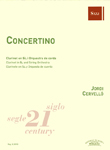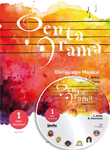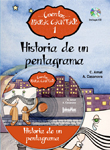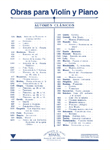Home / Boileau publishing house / History
Delivery in 24h-72h (Peninsula work days)
History
The Music Publishing House Boileau is the oldest active music publishing house in Spain. Its founder, Boileau Alessio Bernasconi, inaugurated it in 1913 from the work in his workshop of engraving and printing. Since then, for over a hundred years, its catalog has expanded to collect more than 3800 titles.
Under the tutelage of four generations has witnessed and has been able to adapt to different historical moments more or less turbulent, it has been an observer of the inherent technological evolution involved in the fact of being in service for more than a century, has followed the musical orientations and the prevailing tastes of the society that it has served at all times, and has had an active participation in the social, musical and cultural life of the city. In addition, it remains in the memories of most of the music students of our territory, many of them have started their studies with the materials of the publisher.
The founder

Alessio Boileau Bernasconi was born in Verona in 1875. After studying piano, oboe and mandolin, he went to work in the publishing house Ricordi in Milan, where he learned the job of engraver. There they offered him the possibility of moving to Greece or Spain, countries where the job of engraver was scarce despite the great social demand for music education of the growing middle classes.
Alessio finally decided to go to Spain, specifically the city of Barcelona, where he moved in 1904 to be incorporated into an active musical society. He founded the Workshops of Music Engraving and Printing A. Boileau & Bernasconi, dedicated primarily to printing commissioned works. In 1906 he settled in Provence street 285 in Barcelona, where still being the workshop of the Publishing House Boileau.
The beginning
The initial activity of the workshop was progressively balancing with the works of own production. The publisher was in charge of all the costs of publishing and promotion, that he recuperated with the proportional part that belonged to him, both for the concept of selling scores as for the copyright and editor. That was how he could start working with the authors of the moment, the majority were teachers of the conservatories of the city. The prestige reached at the workshop earned him commissions for other publishing houses in Spain, as Dotesio or Erviti, and even for some French publishing houses as Salabert or Durand.

Due to the increased demand, Boileau was associated with three partners, Plantada, Alegret and Ros, to create the Publishing House Iberia Musical specialized in the publication of operettas and zarzuelas. In 1913 he absorbed the part of these other publishers and changed the name to Music Publishing House Boileau, preserved until today. With the desire to expand its catalog, he began to publish works of study and repertoire both classical and religious.
In the workshop of the new publishing house, they were working fifteen to twenty engravers, some at part-time and others full-time. Each one engraved an average of one to one and half plates per day. Some of these engravers alternated between this job and being an active musician. In addition, about twelve workers more were involved in the work of the printing.
The first works
Boileau's own production during this first stage (1913-1939) consisted of works by Spanish and foreign composers. Among the different genres, Boileau published lyrical works, religious, hall music in all its forms, fragments of Italian and German operas, as fantasies and arrangements provided on issues of famous works. All of them, very popular genres at those times, were collected in major collections in Boileau: Edición Ibérica, which includes the classic and indispensable repertoire for students of conservatories and music schools; Lauda Sion, with works of religious repertoire; Biblioteca del Pianista, etc...
The didactic production immediately got a very important volume in the catalog of the publishing house. Demand from conservatories and schools generated a solid publishing market, dominated by music methods and piano pieces, followed far behind by works for violin and guitar. The production of chamber music scores for more than three instruments, on the opposite, was almost nil, since its manufacture was too costly because it was directed to a minority audience.
Instead, it had published much music to satisfy the orquestinas which acted in countless dance halls, restaurants and other events with live music, very common at that time. These publications were not sold, but were sent monthly and free to the musicians to incorporate it to their repertoire.
The shop
During the three years of the Spanish Civil War the publishing activity was almost exclusively dedicated to the publication of military music and songs to inflame the different social and politic feelings of the moment. During these years Alessio Boileau was forced to relegate his duties as director and owner of the company to go to work as an operator more.
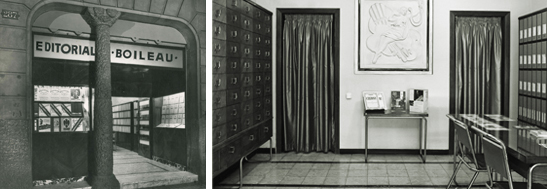
On November 22th, 1939, day of Santa Cecilia, patron saint of music, Alessio opened a shop dedicated to the sale of his publications in the building next to the workshop venue: Provenza, 287. The opening was planned in 1936 but the outbreak of war forced to postpone its opening. The settlement was designed following the inspiration of GATCPAC movement (Group of Catalan Architects and Technicians for the Progress of Contemporary Architecture) and is currently the only establishment of this style that has remained open until today. In 2014 the shop celebrated its 75th anniversary.
A space in the back room was meant to be a concert hall, with enough capacity to locate a mid-sized grand piano and over a hundred chairs. At this makeshift auditorium took place the inaugural concert of the works that were published. It also was a place of musical meetings, featured by important personalities of the musical world of the moment: Enric Morera, Frederic Mompou, Felip Pedrell, Ricard Lamote de Grignon, Enric and Pau Casals, Joan Baptista Lambert or Apel·les Mestres. The gathering also had the assistance of music criticism, that reviewed the concerts in the media.
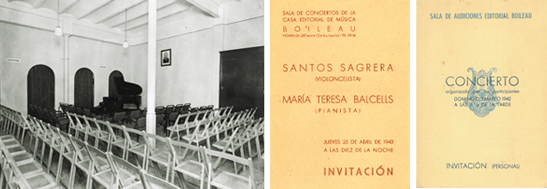
The latest musical sessions at this hall took place in 1949, a year after the death of Alessio Boileau. The analysis of the programs preserved indicates that the cycle had a great activity during his ten years of life, since, according to the times, it had been programmed up even two concerts a week.
Since 40's to nowadays
During the 40's the publishing house had developed a close business relationship and friendship with Higini Anglès, director and founder of the Spanish Institute of Musicology of the Higher Council for Scientific Research (CSIC, in Spanish). At the request of this musicologist, in the workshops of Alessio Boileau, for many years were engraved and printed the copies of the Monuments of Spanish Music Collection, which includes the main national old music with an extensive critical apparatus. Also commissioned by the Library of the Provincial Council of Barcelona, and with the support of Higini Anglès, were published the works of the Masters of the Choir of Montserrat.
With the death of its founder, the Music Publishing House Boileau passed to his daughters, Elvira, Mercedes and Rosario, who took care to continue the activity of the publishing house with the same popularizer spirit of their father. After nearly forty years, in 1986, the third generation also became part of this project. With the addition of Antonio and Yolanda Guasch, grandchildren of Alessio Boileau, the company became a corporation.
Currently, in the publishing house, in the form of limited partnership, they work two of the four generations that have collaborated: the granddaughter and great-grandchildren of Alessio, and also other workers -many of the family of the original template.
During the last hundred years, the publishing house has published approximately 3800 titles, like scores, books and CDs. The largest production still being the scores, in all its varieties -general score, reductions for piano or for voice and piano, parts- and for different types of ensembles -a solo instrument or soloist's voice, chamber, copla, etc. An important set of these is preserved in the Library of Catalonia and in the Library of Congress of the United States of America.
The importance to the publishing house given by the musicology is manifested in the fact that its reference appears in major dictionaries and specialized encyclopedias, both state and foreign, with voices written by José López-Calo (2001), Emilio Casares Rodicio (1999 -2002) and Xosé Aviñoa (2003). One of the most recent contributions to these references has been the writing by the chronicler of Barcelona, Lluís Permanyer (2008), with the premonitory title: Boileau, más de un siglo al servicio de la música (Boileau, more than a century in the service of music).
Over time, the ways of working have changed. In 1993 was the last year that engraved plates for print scores were used. According to the witness of Joaquín Guerin, an old engraver of the publishing house, the Alessio Boileau's workshop was the last surviving with this ancient technique. The introduction of new technologies in printing processes has made it possible to multiply the number of copies to edit, either new titles or reprints of existing, and has changed to a more industrial system of production, compared to the craftwork of the engraver on the plates of tin, antimony and plumb.
However, and as the journalist Lluís Permanyer says: «In just over a century has gone from heavy lithographic stones and plates to computer, but the Publishing House Boileau has adapted very well to these times, while staying loyal to the music».



